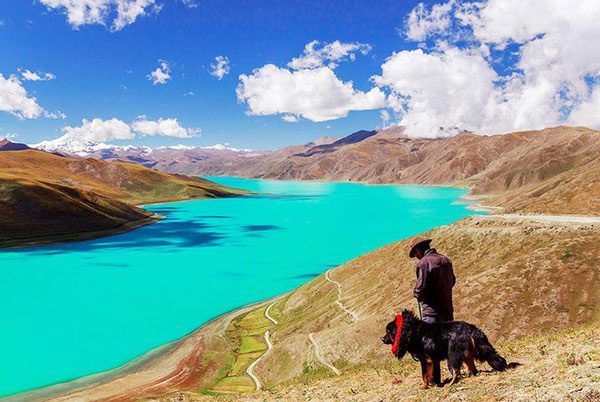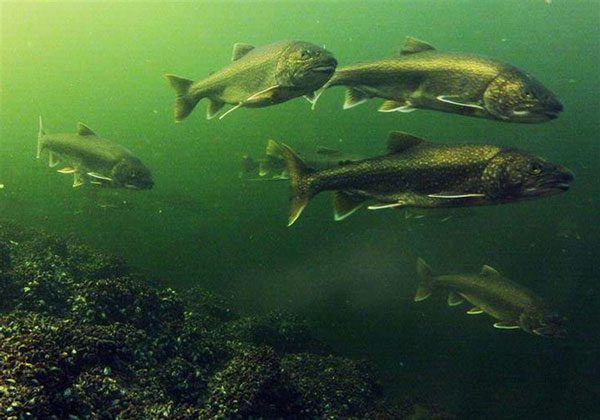Why do the people of Tibet not utilize their natural resources despite not being restricted by the government or the law?
Situated on the highest plateau in the world, with an average elevation of over 4,200 meters above sea level, Tibet is renowned for its Buddhist culture, mystical atmosphere, and unique natural landscapes.
When mentioning “the last pure land on Earth,” one immediately thinks of the sacred Mount Everest, yet this region is also home to numerous vast lakes, with an estimated 1,500 lakes present.
In addition to its diverse terrain that stretches from high mountains to valleys, crossing glaciers and deserts, Tibet surprises visitors with its dense network of rivers and lakes. Among the famous scenic spots here, one cannot overlook the enchanting beauty of Yamdrok Lake (Yamdrok Yumtso).

Scenery of Yamdrok Lake. (Photo: Wordtravel).
Yamdrok covers an area of 675 km2, which is not considered large by Tibetan standards.
However, due to its prime location at an altitude of over 4,440 meters, alongside its breathtaking and pristine mountain scenery, it is regarded as one of the most valuable tourist destinations in this region.
Moreover, the very name Yamdrok reflects the respect and reverence the local people have for the beauty of nature.
“Yamdrok” in Tibetan means “Swan Lake.” In the hearts of the Tibetan people, this lake is seen as a sacred and noble place; they believe that its picturesque beauty is the embodiment of celestial maidens bringing vitality to Tibet.
The Giant Fishery
Besides its pristine beauty reminiscent of a painting, Yamdrok is also known as the “Giant Fishery of Tibet.” Preliminary statistics suggest that the total weight of fish in this sacred lake could exceed 800,000 tons.
In reality, under the conditions of low oxygen and harsh weather in the plateau area, the growth cycle of fish in the lake is much slower compared to lower altitudes. Therefore, the fish population weighing nearly 800,000 tons that we see today is the result of natural growth over hundreds of years in this body of water.

The giant fish population living in Yamdrok Lake. (Photo: post-gazette.com).
Typically, in such a pristine environment, the natural seafood would be highly sought after, but strangely, these fish populations seem to remain untouched.
Why do the local people not utilize this natural resource despite not being restricted by the government or the law?
Holy Symbols
Firstly, the reason Tibetans do not catch fish stems from their traditional dietary habits combined with long-standing religious beliefs. The local cuisine is rich and the ingredients are very clean, with people consuming a lot of meat; however, there are certain animals that they will never touch, including fish.
Just as they regard Yamdrok as the incarnation of celestial maidens, they see the fish in the lakes of Tibet as embodiments of water deities, which is why they never catch fish for any purpose.

Fish regarded as embodiments of water deities in Tibet. (Photo: Sohu).
Additionally, according to various other religious beliefs, the local people believe that if they must kill other beings to sustain their lives, then minimizing killing is always better.
Thus, if given a choice between a cow and a fish, they would opt to kill the cow because killing a cow could sustain a family through an entire winter, while killing a fish would not be sufficient for a meal.
The “Sky Burial” Tradition
Besides dietary habits, traditional burial customs are also one of the important reasons why Tibetans never disrupt the underwater ecosystem in their homeland.
The local people believe that water is the most important element in the world that gives birth to and nurtures life; therefore, when a person dies, returning to merge with Mother Nature in the blue waters is seen as the most peaceful destination.
Thus, to this day, “sky burial” remains one of the burial traditions that Tibetans still commonly practice. Typically, the deceased are wrapped in a white cloth and then set adrift in the river for fish to eat. From this, the local people believe that the souls of their ancestors have entered the fish to continue living.

Sky burial is one of the ancient traditions in Tibet. (Photo: Diamond Tour).
Although Yamdrok is not a common site for sky burials, the belief in the sacred relationship between water and fish, along with the gods and the deceased, has long been rooted in the thoughts of the local people; thus, the massive fish population in the lake seems to have been preserved intact for centuries.
From a scientific perspective, Yamdrok Lake is alkaline, with cold water temperatures year-round. Fish in this cold water grow slowly, and the phytoplankton in the water also struggles to photosynthesize, lacking nutrients. The ability of fish species here to absorb nutrients has evolved so that they take in everything in the lake, accumulating many toxins, likened to “pesticides.” Therefore, it is advised that they should not be consumed.
Located 100 km from the capital Lhasa, Yamdrok Lake in Tibet generates economic benefits for the local area due to its hydropower potential and tourism. Tourism in Tibet thrives thanks to the mystical and sacred colors characteristic of this highland region. Ancient cultural customs and sacred taboos have created the unique style of this enchanting land.
However, visitors to Tibet should be mindful of various aspects. Respect the local culture and beliefs. Avoid violating taboos related to animals, numbers, colors, and more.
The taboos in Tibet create an ancient and mysterious cultural significance, reflecting the people’s reverence for the gods, beliefs, and traditions. In the journey of exploration, understanding, and respecting these customs not only enhances interpersonal communication experiences but also allows you to experience the unique charm of Tibetan culture on a deeper level.
- Thanks to high technology, Saudi Arabia discovers a gold mine 125km long when drilling randomly into the ground
- A vegetable that Chinese people are obsessed with, dubbed ‘longevity vegetable’: Available in many Vietnamese markets!
- Top 12 dishes that centenarians on the Greek longevity island often eat: 11 of which are available in Vietnamese markets!





















































